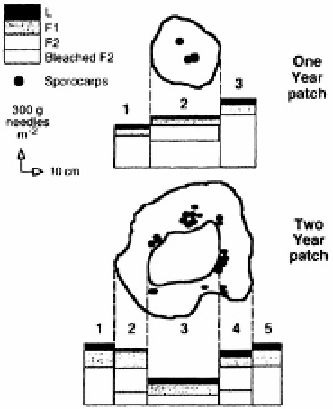Agriculture Reference
In-Depth Information
2.5.4
EFFECTS OF WHITE-ROT FUNGI
Soil and litter acidity and the climatic regime are the major factors determining whether
moder or mor humus types with deep and layered litter systems will form. However, even
in these humus types, rapid decomposition may ensue when conditions become suitable
for the development of basidiomycote white-rot fungi (Section IV.2.5.4). In mixed
stands of Oak (
Quercus robur
) and Beech (
Fagus sylvatica
) in eastern France, Toutain
(1987b) found both moder and acid mull humus types. Soils with an acid mull had twice
as much iron as those with moder litter regimes. The higher iron levels permitted the
development of dense populations of white-rot Basidiomycota, the release of large
amounts of soluble organic matter from the decomposing litter and their insolubilisation
in soil as iron: organic matter complexes. White-rot fungi readily decompose phenol-pro-
tein complexes thereby obviating this chemical limitation to decomposition characteristic
of acid environments (Figure IV.10c) (see
e.g.,
Kirk and Moore, 1972; Eriksson
et al.,
1980; Blanchette, 1984; Adaskaveg and Gilbertson, 1986).
Electron microscope studies have shown that the whitening of decomposing resources
results from the digestion of brown polyphenol-protein compounds (Reisinger
et al.,
1978).
White-rot Basidiomycota can penetrate and progressively digest cellulosic structures and
condensed protoplasmic residues, releasing large amounts of ammonium and soluble
carbohydrates. White-rot fungi may be present in all litter systems and in decomposing
wood. They initially grow as patches but later form expanding annuli with characteristic
'fairy ring' growth patterns (Figure IV.27). They generally grow in the F layer, and
notably in locations where the F2-layers have accumulated to a significant depth
(Gourbière, 1982; Garay, 1989). Litter decomposes much more rapidly as a result of
their activity (Figure IV.5). In temperate forests, they are restricted to places that are
within the reach of growing 'fairy-ring' shaped colonies (Gourbière, 1982).


